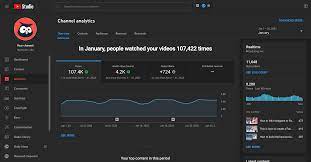Contents
A Comprehensive Guide for Optimal Results
With millions of active users and a vast array of content, YouTube has become an indispensable platform for businesses and individuals alike. To maximize the potential of your YouTube channel, it is essential to conduct a thorough analysis that goes beyond the surface level. In this comprehensive guide, we will provide you with valuable insights warningsolution.com and actionable tips to help you analyze your YouTube channel like a pro, outrank your competitors, and achieve remarkable results.
1. Defining Your Goals and Target Audience
Before diving into the analysis, it is crucial to clearly define your goals and identify your target audience. Are you aiming to increase brand awareness, drive website traffic, or generate leads? Understanding your objectives will guide your analysis and enable you to tailor your content and strategy accordingly. Additionally, gaining a deep understanding of your target audience’s preferences, demographics, and interests will help you create content that resonates with them and keeps them engaged.
2. Assessing Video Performance
One of the key aspects of analyzing your YouTube channel is evaluating the performance of your videos. Start by examining the number of views, likes, dislikes, comments, and shares each video receives. This data will provide insights into the type of content that resonates with your audience. Look for patterns and trends to identify the topics, formats, or styles that attract the most engagement. Analyzing the average view duration and audience retention rate will help you determine if your videos are holding viewers’ attention or if there is room for improvement. How to Analyze a YouTube Channel
3. Examining Channel Metrics
Beyond individual videos, it is essential to delve into your channel metrics to gain a holistic understanding of its performance. Pay attention to the number of subscribers, overall views, and engagement metrics such as likes, comments, and shares across your channel. Analyze the growth rate of your subscriber base over time, as this indicates the effectiveness of your content and marketing efforts. Furthermore, exploring the demographics of your audience, such as age, gender, and location, will enable you to tailor your content to their preferences.
4. Evaluating SEO and Keyword Optimization
To outrank other websites and increase your visibility on YouTube and search engines, optimizing your channel for keywords and SEO is crucial. Start by conducting thorough keyword research to identify the terms and phrases your target audience is searching for. Incorporate these keywords strategically in your video titles, descriptions, tags, and transcripts to increase the likelihood of appearing in relevant search results. Furthermore, analyze the performance of your chosen keywords using tools like YouTube Analytics and Google Trends to refine your optimization strategy continually.
5. Monitoring Audience Engagement
Understanding how your audience engages with your content is vital to refining your YouTube strategy. Dive into the comments section to gain insights into their thoughts, questions, and suggestions. Engage with your viewers by responding to their comments and fostering a sense of community. Pay attention to the audience retention metrics to identify potential areas for improvement. Additionally, analyze the click-through rate (CTR) of your video thumbnails and experiment with different designs to maximize their effectiveness in grabbing viewers’ attention. How to Analyze a YouTube Channel
6. Keeping an Eye on Competition
Analyzing your competitors’ YouTube channels can provide valuable insights and inspiration for your own content strategy. Identify successful channels in your niche and examine their video formats, titles, descriptions, and engagement levels. Look for gaps or opportunities that you can leverage to differentiate yourself and offer unique value to your audience. By understanding the strategies of your competitors, you can refine your own approach and stand out in the crowded YouTube landscape.
7. Leveraging Analytics Tools
Utilizing analytics tools specific to YouTube, such as YouTube Analytics and VidIQ, can significantly enhance your channel analysis. These tools provide in-depth metrics and valuable insights, including audience demographics, traffic sources, and playback locations. Analyzing these data points will enable you to make informed decisions regarding content creation, distribution, and optimization. Stay updated with the latest features and improvements of these tools to ensure you stay ahead of the curve.
8. Continuously Experimenting and Improving
Analyzing your YouTube channel is an ongoing process that requires continuous experimentation and improvement. Keep track of the impact of your changes by monitoring the performance of your videos and channel metrics. Analyze the effectiveness of new strategies, content formats, or optimization techniques and make data-driven decisions to optimize your YouTube presence continually. Remember, success on YouTube is not achieved overnight, but through consistent effort and adaptation.
